Self help zone
Welcome to the self-help zone
Here we have lots of ideas, tips and techniques to help you look after and take care of your mental health and well-being. Many overlap or be combined for greater effect.
Before you say, ‘I’m too busy to do anything else!’, this isn’t about doing more or extra. This is about using what you already have and do, differently, to get more out of them via making simple and subtle changes that could just make that difference between maintaining, or even improving your mental health, and struggling.
Being a learner at Reynolds Training Academy already gives you an advantage over many people. Your learning is in areas that are already proven to maintain and enhance wellbeing such as dance, music, singing, exercise, fitness, nutrition, physical health, massage, and ‘the feeling good’ factor.
However, even in such environments, life’s ‘ups and downs’ occur which can affect well-being in many ways. What could improve your ability to manage life’s stresses, the unexpected, or build your resilience?
Bereavement
During a time of grief, you may not feel like looking after yourself, but it’s important to help you cope with the extreme emotions that come with bereavement.
Some of the following simple things can make a big difference, such as:
- eating – you may lose your appetite, but try to keep eating as normally as possible: your body needs food, even if you don’t want it; ideally, go for healthy, well-balanced meals.
- socialising – seeing your friends and keeping up a normal social life may help take your mind off things and allow you to talk about how you’re doing, if you want to; but don’t feel guilty about not thinking about the person you’ve lost or having a good laugh with friends.
- exercising – regular exercise can make you feel good and help you sleep (but avoid doing vigorous exercise close to bedtime); it can also be a relief to focus on something physical when you’re going through an emotional time.
- avoiding smoking, drinking and taking drugs – you may feel like smoking or drinking because you feel down, but your body has to work hard to deal with substances such as nicotine, alcohol or illegal drugs, especially when you’re young, and they’ll end up making you feel worse.
Read on for more self-help ideas:
Self help zone
Personal clues and cues
These are your body’s ‘non-verbal communications’. They tell us something – clues that something’s amiss and a cue to do something – or at very least pause, stop and think about what’s going on for you and what to do, now or later.
Whilst we may think or believe we’re OK, our body often tells us otherwise via a combination of a variety of physical, behavioural, cognitive, emotional change indicators which we may or may not be aware of, or pay attention to. You might just be having ‘an off day’, although still worth paying attention to, especially if ‘those days’ continue.
We often sense or notice changes in our friends, family, other learners, such as temperament, habits, attitude changes. They may be behaving ‘out of character’. Perhaps they seem tense, anxious, fidgety, or unusually quiet or withdrawn. If you’re able to recognise changes in others, you can transfer that skill to yourselves.
Then you can get to know your signs too and, over time, any patterns, triggers and particular situations too. Then you can take any appropriate action, sooner rather than later, or not at all.
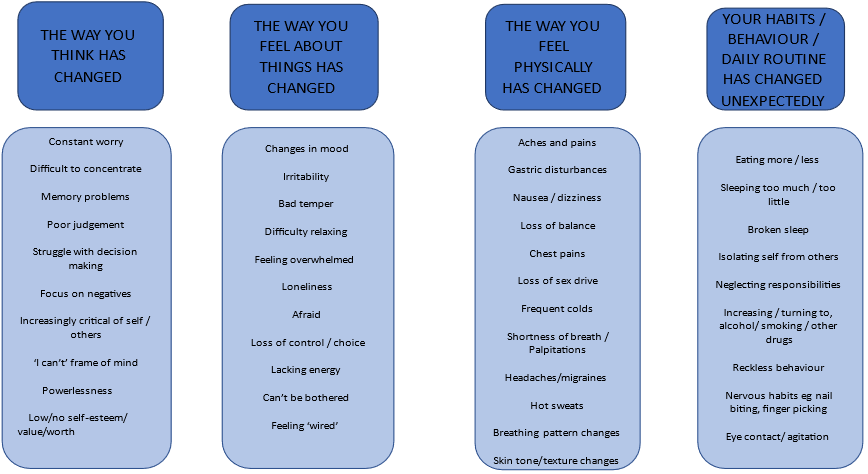
Here’s some examples and usually a combination of factors rather than one in isolation.
Being honest with yourself, can you identify any of yours yet?
Take a little quiet time each day
Make a conscious effort to gift yourself these moments whether at home, college or play. They may be ordinary or extraordinary moments, active, still or quiet moments, with friends, family, other learners or alone. They may be inspired by a thought, a person, a cherished memory or reminder of something we hold dear.
You can utilise times where you’re waiting for something too. For instance while waiting for your next class, the bus, your friend, your client. Use these ‘waiting’ moments as a ‘mini-break’ instead of perhaps getting frustrated they’re not happening quickly enough! These self-gift moments re-fresh, re-energise, can simply lift spirits and help you unwind momentarily. You could use them as mindfulness or breathing moments too.
Setting aside specific time to yourself for any task or activity that matters to you, or finding a quiet place to prepare for an assessment, exam, prepare a client’s fitness programme, or practice a dance, song etc can become your quiet time.
What might, or could, your quiet time be?
Hygge moments
A Danish trend pronounced ‘hue-gah’, for acknowledging a feeling or moment as cosy, snug, content, charming or special, of enjoying life’s simple pleasures. It’s more about atmosphere and experience, less about things.
For example: If you’ve ever enjoyed reading a book indoors on a rainy day, watching your favourite film with friends, a cup of hot chocolate on a cold, miserable day, lazy Sunday afternoons, snuggled up on the sofa, you’ve probably experienced ‘hygge’. Here’s 5 ideas for starters:
- Your surroundings. You might often experience ‘hygge’ without realising! Those ‘lost in the moment’ moments for example walking a dog on a lovely day; being at your ‘special’ place; or the sun on your face, the wind in your hair.
- Your special mug, water bottle, college bag or similar, can be comforting and grounding when things around us are happening. Take time to enjoy ‘tea and talk’ and give your brain a break!
- Make a playlist. Music does wonders for the mind. Select your favourites, or meaningful tunes whichever works for you. It’s portable too so will help anywhere you are.
- Sit and eat your lunch rather than eat ‘on the go’. It’s better for your digestion too! Focus and be ‘in the moment’. Avoid planning or thinking about what’s next and practice not looking at ‘phones or social media. Instead, focus on your food; what you’re eating, drinking, using all your senses to experience it eg. what it looks, smells, tastes, feels like.
- Personalise things or places. For example your area of the changing room; your desk, your learning area, with something meaningful, sentimental from your personal life. Having some sort of personal item that is special/unique for you, can make a difference.
Think about what’s your hygge moment?
Mind fullness
Is the art of being present. Times when your mind-is-full, 100% focused in the moment. Many associate, mindfulness with meditation. However, a mind fullness state of mind can be form of meditation ie. nothing else matters in that moment other than that moment.
Mindfulness can be a useful technique to help with stress, anxiety and depression. It enables ‘switching off’ moments from what is going on around you, tuning in to the ‘here and now’. According to modern research, mindfulness:
- Down-regulates fight/flight and freeze activity stimulated often by stress, stressful situations, by decreasing the release of cortisol, the stress hormone. Lower levels of cortisol are linked with feeling calm, relaxed, content, peaceful yet with a fully focused brain as the decision-making part of the brain, the pre-frontal cortex, is not ‘blocked’ by excessive cortisol.
- Up-regulates intuition, empathy and action. It gets you in touch with yourself, others and the environment, enabling you to respond skilfully and appropriately rather than habitually or your default response.
Any activity – performing, exercising, a beaty treatment, observing others, a hobby, pastime, even learning, can become mind fulness moments; you’re so immersed and absorbed in the activity with a razor sharp, 100% focus on the minute detail – your mind is full – that all thoughts, feelings of other ‘stuff’ is parked, giving your mind a break.
So, when are your mind-full moments?
Breathing
Probably the most underestimated and overlooked technique we have. We all breathe! However, by paying attention to it, we can use it, alter it to affect/change to how we feel, think, behave, our physiology etc.
We sometimes hold our breath when concentrating. How many learners have heard tutors calling out “And breathe!!”. We can all experience anxiety, panic even, in certain situations, with rapid or shortness of breath and a raised heart rate etc.
Breathing deeply slows down the release of cortisol, the stress hormone, and lowers heart rate as oxygen levels are regularised. That’s why there’s a link between stress and breathing. Stress heightens the symptoms of anxiety and depression, which is why breathing indirectly helps these too. Regularised oxygen levels reduce anxiety and uplift depressive mood.
Try these useful techniques which can be done anytime, anyplace, anywhere. Sitting, standing, waiting in the wings, waiting for a client, before an assessment, audition or exam. They can double up as mind fullness moments too.
- Let it go! If you find yourself holding your breath, breathe out, long and slow!!
- The slow 7, or whatever count works for you. Take these slow, very deep, soft breaths. Focusing 100% on your breath is cited as a great calming technique for particularly stressful, anxious situations. Do not rush these; allow time to complete the cycles. You can do this to yourself or talk someone else through it.
- 4-4-4 technique. Breathe in, to a slow count of 4, hold for 4, breathe out for 4.
- 4-7 technique. Breathe in to a count of 4, hold for 4, breath out very slowly to a count of 7. Breathing out longer than we’ve breathed in is a good way to reduce anxiety, stress, lower blood pressure etc.
- The paper bag alternative. It’s often said to hold a paper bag over our mouth and nose, if we’re in a state of panic, anxiety, taking very short quick breaths, getting light-headed and dizzy. What happens is the excess oxygen in our body/bloodstream taken in by the quick, sharp, short breaths, gets neutralised by the carbon dioxide temporarily breathed in that builds up in the paper bag. Who carries or has access to paper bags these days!
- However, a more practical way is to cup your hands, use a scarf or your sleeve, and place over your nose and mouth. This has the same affect but is easier, more practical and, discreet.
https://www.nhs.uk/conditions/stress-anxiety-depression/ways-relieve-stress/
Try some out! – experience the difference a cycle(s) of slow breathing makes.
Body language
By simply adjusting or changing your posture, we can feel different. It can affect our confidence too.
Changing our body posture and body language also impacts others. We can create different impression(s) simply by changing our posture.
Try this simple exercise:
- sit/stand slumped, round shouldered, belly squashed, eyes downward.
- Take a few moments to explore how you feel in that position. What words come to mind?
- Then, sit/stand straight, lift up from under your ribs, shoulders gently back and down, feel the ground beneath your feet, head level, eyes forward.
- Explore how you feel now.
- Compare and contrast the two positions. Which one feels ‘better’? Which do you prefer?
Your body language, your posture, whether standing, sitting or moving makes a difference to you, your impact on, and others’ perception of you. It sends messages to tutors, other learners, audition panels, clients whether beauty and fitness, friends family etc . By simply adjusting or changing your posture, you can change a situation too. A very useful tool for ‘Courageous Conversations too.
Take a look at Amy Cuddy, the world renowed body language expert’s TED talk, including the ‘power pose’ – one of the most popular TED talks of all time.
When might this skill be useful?
Mood management; smiling inside
What mood are you in? Can you identify it? Are you OK with it, or do you want to change it, and to what? Is it affecting you/your work, your learning, others? How do we regulate, change, alter our mood?
We can all comment or recognise someone else’s mood. ‘Oh, [x] is very stroppy today!” But what have you based your opinion on?!
Transferring that observation skill to ourselves, recognising any changes, thinking how we’d like to be – enables us to make changes.
One of the simplest, quickest and easiest techniques to lighten our mood is to think about or do something that makes us smile. Our special thing – a memory, a place, a pet, an inspirational quote, a loved one, song, event.
Smiling releases pleasure hormones called endorphins, natural painkillers and antidepressant hormones such as serotonin. Smiling reduces stress and boosts your immune system. Smiling changes our physiology, our body language. Granted, openly smiling in certain situations may be inappropriate, but you can still smile inside – somehow it’s special.
And remember to have fun! It’s easy to forget when we’re absorbed in what we’re doing. Humour, laughter, smiling is a great stress reliever, and proven good for well-being.
Go on, think of someone, something, some time/event dear to you, to get you smiling inside – how do you feel?
Watch your language

… and how we use them, how we say them too speak volumes about what’s going on for us.
Here’s 5 top language tips:
Notice when ‘Should, ought, must, have to, got to’ creep in. Psychologically, these have a negative, limiting, pressurising affect. Change to ‘would like/need/want/choose to’ or ‘be a good idea if…..’ Their impact is to put/give us back control and choice which boosts well-being.
Listen to any self-talk tone. When it slips from ‘inner cheerleader’ – encouraging, gently pushing – to harsh, angry, driven.
Pay attention to ‘time-out’ language. Phrases such as ‘Give me a break; I need a moment; I need a breather; give me 5; hold on a moment; give me some space; I need to step away/take a moment; my brain’s not working; my mind’s not on the job; creep in. They are telling you exactly what you’re saying and what to do…..take a break!
Change ‘cope’ to ‘manage’. Cope is defined as ‘deal effectively with something difficult’ & ‘have the capacity to deal successfully with’. However, its sound, and psychological impact somehow has a positive/negative vibe. It has connotations around struggling, just about getting by. ‘Managing’ has positive/positive affect, and somehow sounds uplifting – puts ourselves (back) in control. Try it! Check out your own reactions to both words.
Remember choice – notice ‘I don’t have any choice about….’ language. Remind yourself you do! Sometimes we think we don’t, but often we’re focusing on the consequence of the choice rather than the choice itself. Plus, sometimes things happen we have no control over, but we do have choice how we manage it.
What’s your language indicator?
Your 5-a-day
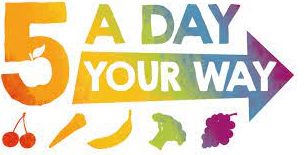
No, not the fruit and veg kind! 5 things a day that are just for you, to help your well-being. Often simpler and easier than you might think as you’re probably doing many already. For example:
- Having tea/coffee in your favourite mug.
- Mindfully dancing, singing, massaging, exercising,
- Breathing exercise.
- Listening to music.
- A quick sensory ‘top to toe’ audit of yourself – any adjustments needed?
- Remember your favourite quote, an inspirational person.
- Bath/shower using your favourite products.
- Wearing something a loved one bought you.
- Check out Reynolds Training Academy wellbeing hub.
- Change your posture.
- Smile – inside or overtly.Take 5 or timeout.
- Conversation with loved ones. And so much more….
What’s your five a day?
Check your battery....
No, not your ‘phone’s, yours!! And re-charge, top-up as necessary!
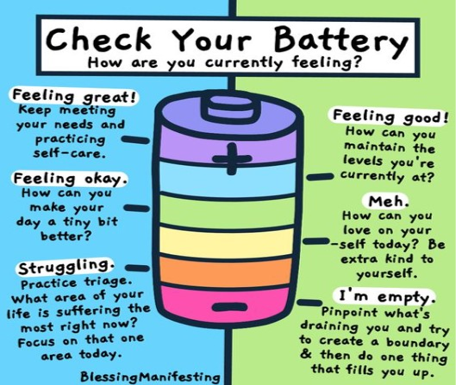
What are your battery levels today? How do you re-charge?
Get your daily d.o.s.e.
 DOPAMINE – the reward chemical. Activities such as completing a task, self-care, eating good food, celebrating little wins.
DOPAMINE – the reward chemical. Activities such as completing a task, self-care, eating good food, celebrating little wins.
 OXYTOCIN – the love hormone. Activities such as holding hands, cuddles, hugging, giving compliments, playing with pets.
OXYTOCIN – the love hormone. Activities such as holding hands, cuddles, hugging, giving compliments, playing with pets.
 SERATONIN – the mood stabiliser. Activities such as meditating, sunshine, walking in nature, swimming, cycling, dancing, singing, massage.
SERATONIN – the mood stabiliser. Activities such as meditating, sunshine, walking in nature, swimming, cycling, dancing, singing, massage.
 ENDORPHIN – the pain killer. Activities such as laughing, essential oils, watching comedy, exercising, having fun.
ENDORPHIN – the pain killer. Activities such as laughing, essential oils, watching comedy, exercising, having fun.
How do you get your D.O.S.E?
Control the controllables
Focus on the things you can control, rather than those you cannot!
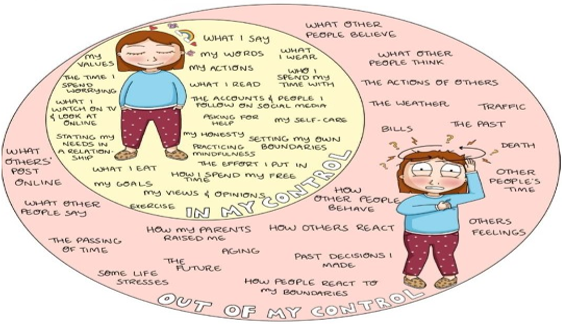
What’s within your control?
And if nothing else, s.t.o.p and/or w.i.n
In those moments when you sense you’re not OK, not your normal self, under pressure, stressed, ‘up against it’, too much going on etc,
Wind your shoulders back and down, relax your forehead and jaw, and….
Think…..what do I need more of? what do I want to have happen? what can and will I do differently?
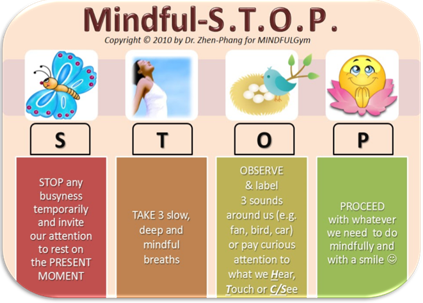
And remember…… W.I.N ….
What’s Important Now?
… helps prioritise, focus, and gets things done!

